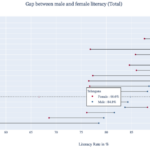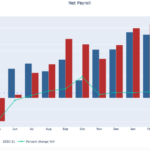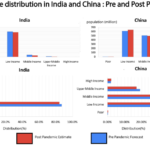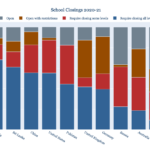ASER 2021: The Pandemic Widens the Gap
Key Takeaways:
- The percentage of children aged 6-14 not enrolled in any school in India rose to 4.6 percent in ASER 2020 and 2021 from 2.5 percent in the pre-pandemic survey, ASER 2018.
- Sharper rise in percentage of younger children (aged 6-10) not enrolled in school, as per ASER 2021 (over ASER 2018) than older children (aged 11-14).
- Decline in 15-16-year-olds not enrolled in school from 12 percent in ASER 2018 to 6.6 percent in ASER 2021.
- A higher percentage of students have enrolled in government schools since the onset of Covid-19 pandemic than were enrolled before it.
- Decline in private school enrollment is a reversal of trend seen between 2006 to 2014 which saw a steady increase in private school enrollment.
- ASER notes a steady increase in children taking private tuitions in 2020 and 2021 (during the pandemic) vs 2018 (before the pandemic).
- The increase in children taking private tuitions is sharpest among children from disadvantaged households.
The Covid-19 pandemic has had a profound impact on the world. It has affected healthcare, supply chains, trade, economy, and employment among others. The pandemic has also affected the field of education. Sharp rise in cases around the world in various waves, forced schools, colleges, and universities to suspend in-person classes and move to learn-from-home using the internet. The suspension of in-person classes brought with it newer challenges for students, teachers, and educational institutions alike. For some students in rural India, the pandemic may have increased the gap between those who have access to electronic devices (smartphones, laptops etc.) to access instruction from home and those who don’t. For other students from disadvantaged households, it may have made it harder to enroll in schools.
In September 2021, we looked at how the pandemic had affected regular schooling in the country in a Picture This post. Using the Oxford Covid-19 Government Response Tracker, we compared the status of schools in India with the rest of the world. According to the tracker, between January 1, 2021, and September 1, 2021, Indian schools functioned normally for only 11 percent of the days while the remaining 89 percent of the days saw some form of restrictions on some schools, if not outright closure.
The recently released Annual Status of Education Report (ASER) (Rural) 2021 delves deeper and tries to answer how Covid-19 affected schools, students, families, and learning.
Annual Status of Education Report (ASER)
ASER is a “… a citizen-led household survey that provides nationally representative estimates of children’s schooling status and their foundational reading and arithmetic skills.” It has been conducted annually between 2005 and 2014 and biannually between 2014 and 2018. Conducted by volunteers, it surveys children aged 3 to 16 years in all rural districts. However, the pandemic affected this survey in the years 2020 and 2021 and it was conducted as a phone survey in which volunteers spoke to parents and teachers to understand how children aged 5-16 have studied at home.
ASER 2021 has covered 7,299 schools in 17,184 villages spread over 581 districts in 25 states and 3 Union Territories (UTs). It tries to answer questions related to student enrollment, private tuitions, smartphone availability and access, learning support at home, access to and availability of learning material among others.
Children not going to school
Figure 1 shows us the state-wise percentage of children aged 6-14 currently not enrolled in school, as per ASER 2018, 2020, and 2021.
Across India, 2.5 percent of children aged 6-14 were not enrolled in any school, as per ASER 2018. This figure was slightly higher for girls (2.6 percent) than for boys (2.3 percent). As the pandemic struck in 2020, the percentage of children not enrolled in any school rose to 4.6 percent, as per ASER 2020 (4.6 percent for both boys and girls). In ASER 2021, while the overall percentage of children (6-14-year-old) not enrolled in school has remained at 4.6 percent, there has been an increase in percentage for boys (4.8 percent) and a decrease for girls (4.4 percent).
Among states, the highest percentage of children not enrolled in any school, as per ASER 2021, is seen in Nagaland at 19.6 percent, followed by Manipur at 15.5 percent, and Telangana at 11.8 percent. The lowest percentage of children not enrolled in a school is seen in Himachal Pradesh at 0.6 percent followed by Chhattisgarh at 0.9 percent.
Figure 1
While Figure 1, shows us the percentage of children aged 6-14 not enrolled in schools, Figure 2, provides us this information at the national level for three age groups, 6-10, 11-14, and 15-16.
For children aged 6-10 the percentage of children not enrolled in a school increased from 1.8 percent in ASER 2018 (pre-pandemic) to 5.3 percent in ASER 2020, and 5 percent in ASER 2021. The increase is not so sharp for the children aged 11-14. For this age group, the percentage of children not enrolled in a school increased from 3.2 percent in ASER 2018 to 3.9 percent in ASER 2020, and 4.1 percent in ASER 2021. Thus, we can see that there are fewer children (in terms of percentage) aged 11-14 who are not enrolled in school as compared to children aged 6-10.
For the age group 15-16, we see a reduction in the percentage of children not enrolled in school. From a high of 12 percent this number decreased to 9.9 percent in ASER 2020 and further down to 6.6 percent in ASER 2021.
Figure 2
Enrollment: Government vs Private School
Table 1 shows the percentage of students enrolled in a government school by grade and gender, as per ASER 2018, 2020, and 2021. We can see that a higher percentage of students have enrolled in government schools since the onset of Covid-19 pandemic than were enrolled before it.
The rise in enrollment in government schools is a departure from the trend seen between 2006 and 2014 which saw a steady increase in enrollment in private schools. ASER 2021 quotes a UNICEF report on closure of low-cost private schools during the pandemic as a possible reason for this decline.
The data also shows that a higher percentage of girls have been enrolled in government schools compared to boys since ASER 2018. However, this gap has narrowed in ASER 2021 with 71.9 percent boys enrolled in government schools as compared to 76.5 percent girls.
The rise in enrollment in government schools is seen across all grades as well. While in the pre-pandemic period, 57.9 percent boys and 65.1 percent girls in grades I and II were enrolled in government schools (ASER 2018), it rose to 72 percent for boys and 74.1 percent for girls in ASER 2021.
Table 1: Percentage of children enrolled in government schools by sex and grade.
| Std | ASER 2018 | ASER 2020 | ASER 2021 | |||
|---|---|---|---|---|---|---|
| Boys | Girls | Boys | Girls | Boys | Girls | |
| Std I-II | 57.9 | 65.1 | 61.1 | 66.7 | 72 | 74.1 |
| Std III-V | 62.7 | 71.2 | 65.6 | 73.3 | 70.9 | 77.1 |
| Std VI-VIII | 65.8 | 73.3 | 68.3 | 77 | 73.4 | 79.2 |
| Std IX & above | 64.6 | 68.9 | 69.7 | 72.7 | 71.2 | 74.3 |
| All | 62.8 | 70 | 66.4 | 73 | 71.9 | 76.5 |
Enrollment in States
Figure 3 shows the percentage of boys, girls or all children aged 6-14 enrolled in a government school, as per ASER 2018, ASER 2020, ASER 2021. Select the survey using the slider in the top right corner and then hover over a state to find the data for that round of survey. Among the states covered in ASER 2021, the lowest percentage of student enrollment in government schools (6–14-year-olds) is seen in three north eastern states, viz Manipur (13.4 percent), Meghalaya (33.9 percent), and Nagaland (34.8 percent).
Figure 3
Among larger Indian states, Haryana has the lowest percentage of student enrollment in government schools at 48.3 percent, as per ASER 2021. The pan-India average is 70.3 percent. The highest student enrollment in government schools is seen in West Bengal at 91.8 percent, followed by Gujarat at 85.2 percent.
North Indian states like Haryana, Himachal Pradesh, Punjab, Jammu & Kashmir, and Uttar Pradesh have a lower percentage of student enrollment in government schools. Andhra Pradesh, Chhattisgarh, Tamil Nadu, Karnataka, Bihar, Jharkhand, Odisha, Gujarat, and West Bengal are states where the percentage of students enrolled in government schools is higher than the national average.
The decline in private school enrollment (for 6-14-year-olds) seen in ASER 2020 and ASER 2020 (over ASER 2018) may have several causes. This may be because of the closure of low-cost private schools during the pandemic, as the UNICEF report quoted in ASER 2021 asserts. Thus, it may be because of demand vs supply factors. It could also be affected by falling family incomes during this period. In a CEDA-CMIE bulletin, we had observed the decline in individual wage income and total household income in rural India because of the pandemic induced lockdowns.
Private Tuitions
ASER 2021 reports an increase in students taking private tuitions. Table 2 shows the percentage of enrolled children taking private tuition by school type. While in 2018, 28.6 percent of all enrolled children (government and private schools) took private tuition, this figure has risen sharply to 39.2 percent by 2021. We don’t see a significant difference between government and private schools in terms of proportions taking private tuition even though the percentage of children enrolled in government schools taking private tuition is marginally higher than those enrolled in private schools.
Table 2: Percentage of enrolled children taking private tuition – By school type
| School type | ASER 2018 | ASER 2020 | ASER 2021 |
|---|---|---|---|
| Govt | 29.6 | 33 | 39.5 |
| Pvt | 26.7 | 31.2 | 38.2 |
| Govt & Pvt | 28.6 | 32.5 | 39.2 |
Table 3 shows the percentage of children taking private tuitions by sex. Here too we can see a steady increase in students taking private tuitions across both sexes although the percentage of boys taking private tuitions remains a little higher than girls.
Table 3: Percentage of enrolled children taking private tuition – By sex
| Sex | ASER 2018 | ASER 2020 | ASER 2021 |
|---|---|---|---|
| Boys | 30 | 33.6 | 40.3 |
| Girls | 27.2 | 31.2 | 37.9 |
| All | 28.6 | 32.5 | 39.2 |
Table 4 shows the percentage of children taking private tuitions by parents’ education. The survey takes parents’ education as a proxy for their economic status. Here we can see the sharpest rise among children whose parents have a low level of education (both parents have completed Std V or less). In 2018, 24.5 percent of such children took private tuition. This proportion has risen to 37.1 percent in 2021, a rise of 12.6 percentage points. Thus, the sharpest rise is seen in the most disadvantaged households.
The high education category comprises children both of whose parents have completed at least Std IX. All other parents are included in the “medium” category. The lowest increase in percentage of children taking private tuitions is seen in the higher education category. Their percentage has increased from 34.5 percent in 2018 to 41.7 percent in 2021.
Table 4: Percentage of enrolled children taking private tuition – By parents’ education
| Education | ASER 2018 | ASER 2020 | ASER 2021 |
|---|---|---|---|
| Low | 24.5 | 29.8 | 37.1 |
| Medium | 29.1 | 33.2 | 39 |
| High | 34.5 | 33.9 | 41.7 |
Tables 2, 3, and 4 show that the increase in percentage of children taking private tuitions post-pandemic can be seen across school type, sex, parents’ education etc. Table 5 (below) however, shows the difference in percentage of enrolled children taking private tuitions by school reopening status. We can see a lower percentage of enrolled children taking private tuition across all grades for children whose schools had reopened at the time of the survey. The survey notes that “private tuitions were more common among children whose schools were still closed at the time of the survey.”
Table 5: Percentage of enrolled children taking private tuition – By grade and school reopening status
| Std | School not reopened | School reopened |
|---|---|---|
| Std I-II | 37.7 | 36.6 |
| Std III-V | 41.6 | 38 |
| Std VI-VIII | 41.6 | 37.6 |
| Std IX & above | 45.7 | 40.1 |
| All | 41.2 | 38.2 |
Smartphones: Availability and access
Online instruction requires students to have access to electronic devices like smartphones, desktops, and laptops to be able to attend classes. ASER 2021 answers some questions about the availability of and access to smartphones for children trying to attend classes online. However, the survey does not provide us information on the availability of desktops or laptops at home.
Table 6 shows the availability of smartphones for enrolled children at home by school type. It shows that the availability of smartphones at home has nearly doubled between ASER 2018 and ASER 2021. From 36.5 percent of enrolled children having smartphones at home in ASER 2018, it has increased to 67.6 percent in ASER 2021. For children enrolled in government schools, their percentage has more than doubled from 29.6 percent in ASER 2018 to 63.7 percent in ASER 2021.
Table 6: Percentage of enrolled children who have a smartphone available at home.
| School Type | ASER 2018 | ASER 2020 | ASER 2021 |
|---|---|---|---|
| Govt | 29.6 | 56.4 | 63.7 |
| Pvt | 49.9 | 74.2 | 79 |
| Govt & Pvt | 36.5 | 61.8 | 67.6 |
ASER 2021 delves deeper on this question to find availability of smartphones by parents’ economic status. Once again, it uses parents’ education as a proxy for their economic status (similar to Table 4).
Table 7 shows the change in availability of at least one smartphone at home by parents’ education in 2020 and 2021. We can see that disadvantaged households have lower availability of smartphones for enrolled children. Moreover, in 2020, fewer low education category parents were able to buy a new smartphone for their children’s education. But, in 2021, the percentage of households who bought a new smartphone for children’s education since March 2020 was comparable across all income/education groups.
Table 7: Percentage of enrolled children with at least one smartphone available at home. By parents’ education
| Parents’ Education | ASER 2020 | ASER 2021 | ||
|---|---|---|---|---|
| At least one smartphone available at home | Bought a new smartphone for children’s education since March 2020 | At least one smartphone available at home | Bought a new smartphone for children’s education since March 2020 | |
| Low | 45.1 | 5.2 | 52 | 26.8 |
| Medium | 60.2 | 8.8 | 66.1 | 27.3 |
| High | 78.7 | 13 | 81.8 | 29.3 |
| All | 61.9 | 9.1 | 67.7 | 27.9 |
However, the availability of a smartphone at home may not be a guarantee of access to a smartphone for education. Figure 4 shows the state-wise percentage of enrolled children who first have at least one smartphone available at home, and then the percentage of these children who can access it all the time, some of the time, or never.
Figure 4
Among the states covered in ASER 2021, we can see that Kerala, at 97.5 percent, had the highest percentage of enrolled children who had at least one smartphone available at home. Not only that, but they were also able to access it more than children enrolled in other states. 76.2 percent of children who had smartphones available at home were able to always access it for their studies. 21.2 percent were able to access it at some times while only 2.6 percent children were never able to access it for their studies.
Himachal Pradesh had the second highest availability of at least one smartphone at home for enrolled children at 95.6 percent but only 25.1 percent of these children were able to always access it. This shows that availability does not guarantee access.
At the national level, 67.6 percent of enrolled children had a smartphone available at home for studies. Only 27 percent were able to always access it, 47 percent were sometimes able to access it while 26.1 percent were never able to access it.
Getting help at home
Table 8 shows the percentage of enrolled children who received help from a family member while studying at home. We see a decline in the percentage of enrolled children getting help from family members in ASER 2021 as compared to ASER 2020. This is seen in the case of both government school and private school students.
Table 8: Percentage of enrolled children who received help from family members
| School Type | ASER 2020 | ASER 2021 |
|---|---|---|
| Govt | 72.6 | 64.8 |
| Pvt | 80 | 71.9 |
| Govt & Pvt | 74.9 | 66.6 |
Table 9 shows us the percentage of enrolled children who received help from family members, by parents’ education. While we see an overall decline in children receiving help from a family member while studying at home (as seen in Table 8), Table 9 shows us that this percentage is relatively higher for children with higher parental education (both parents completed at least Std IX).
Table 9: Percentage of enrolled children who received help from family members by parents’ education
| Education | ASER 2020 | ASER 2021 |
|---|---|---|
| Low | 54.8 | 46.8 |
| Medium | 76.5 | 67.8 |
| High | 89.4 | 79.9 |
Conclusion
ASER 2021 reveals the impact of the Covid-19 pandemic on schooling in the country. We see an increase in enrollment in government schools across India, which points to possible distress for low-cost private schools and lower income households. The increase in children not enrolled in any school in both ASER 2020 and ASER 2021, shows us how the pandemic has affected the education of children aged 6-14.
ASER 2021 also reveals an increasing trend of enrolled children taking paid private tuitions. The largest increase is seen among children who belong to more disadvantaged households. The pandemic has affected the functioning of schools and teaching has been shifted to electronic classrooms. This has made the availability of and access to smartphones critical for education. ASER 2021 reveals a sharp rise in availability of smartphones for enrolled children at home since the pandemic began. It also highlights sharp inequities across states and economic class when it comes to full time access to these smartphones for studies. This shows that the pandemic has made the situation even more challenging for children from disadvantaged households. However, the survey could’ve presented a more rounded picture of the availability of devices to access online instruction, had it also included questions about the availability of desktops and laptops.
Thus, ASER 2021 reveals how the pandemic has affected learning for India’s school-going children and how it has widened the gap between the haves and the have-nots.
If you wish to republish this article or use an extract or chart, please read CEDA’s republishing guidelines.




